Auke Visser´s ESSO Tankvaart Mij. Site | home
Tanker To Norway
Written by Paul F. Hoye & Photographed by Burnett H. Moody
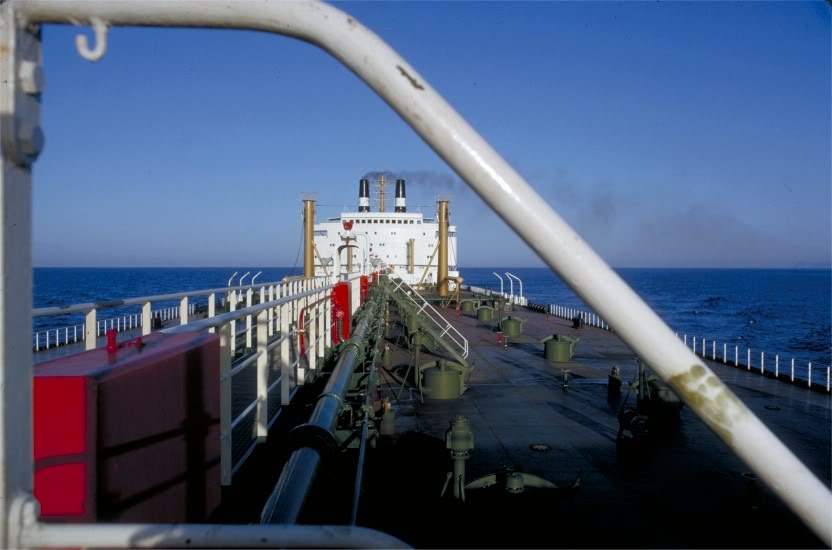
Photo : Burnett H. Moody/Saudi Aramco World/PADIA
For most of a day and all of a night the tanker had been loading petroleum.
Hour after hour, from the great steel tanks on the hill 6,000 feet away, crude oil from the fields of Saudi Arabia had poured aboard, gurgling
quietly through the long green mains into the dark cavities that stretch between bridge and forecastle. Hour after hour the high-riding hull
had settled more deeply into the water.
Now, at dawn, it was time to prepare for sea. The rubber loading hoses were uncoupled from the manifold; the steel cables and heavy nyl-
on hawsers were winched in and stowed; the second of two massive bow anchors was dragged dripping from the water. A moment later
the ship began to move, the stern pivoting toward shore, the bow toward the open sea. Black smoke belched from the twin stacks on the
funnel deck and three shattering blasts from the whistle banged hoarsely against the purple hills of Sidon. The ship, steady on a heading
of 277 degrees, steamed west across the Mediterranean. Her name was the Esso Den Haag. Her destination was Norway.
There is a definite rhythm to a sea voyage. It begins on a note of excitement, levels off to a placid monotony, rises and falls with the ap-
proach of other ships, or with the advent of storms and fog, climbs to a peak in a moment of challenge and then, one evening, or one
morning, as the outline of a harbor takes shape on a distant horizon, subsides.
Aboard the Den-Haag the excitement Was short-lived. The crew coiled lines, cleared the clutter from the deck and disappeared, leaving
the decks deserted and silent. The Chief Steward, shivering in the numbing zero-degree cold of a galley freezer, chose the meat for the
evening meal. The Chief Engineer checked pressure readings of instruments for an indication of some flaw he suspected in the turbine.
The Second Officer took over the watch, and Captain Huibert Jansen retired to his cabin to pack his pipe and talk. The sun was warm, the
sea blue and all, for the moment, was well.
"It will probably be a calm voyage," said Captain Jansen. "It usually is, this time of the year, and we have made this trip before, many
times. But at sea," he shrugged expressively, "at sea, you never know."
He gestured with his pipe toward the starboard side of the ship. "Down there on the poop deck there's a gap in the rail: and there's a ladder
lashed to the railings nearby. The gap is where the ladder used to be. It is quarter-inch steel, that ladder, but when we started taking green
water aboard in the South Atlantic one day it tore like a strip of cardboard."
The captain's words were a gentle reminder that if oil is the central fact aboard a tanker, it is not the only fact. A tanker is also a ship and
Captain Jansen made it abundantly clear that once the" last hose was disconnected and the? last valve was closed, it was to the ship
and the long voyage ahead that he would give his full and undivided attention.
From Sidon, huddled against the Lebanese coast at the eastern end of the Mediterranean, to Slagen, tucked behind the wooded head-
land of a fiord in Norway, stretch nearly 4,000 nautical miles of sea. For a ship that at that point had already traveled nearly 240,000 miles
it was not a remarkable voyage in any way. Yet the course that Captain Jansen had begun to lay out on the large numbered charts in the
chartroom was to take the Den Haag through some of the most historic, the most beautiful and, on occasions, the most dangerous seas,
oceans, straits, bays and inlets in the world. And first was the Mediterranean.
In all the world there is no waterway to compare with the Mediterranean Sea. Along her shores have risen two of the world's great religions
and most of the ancient civilizations: Egyptian, Greek, Roman, Arab, Byzantine, Ottoman. On her waters have sailed the men, great and
near-great, legendary and starkly real, who have created, altered or inspired much of the history, philosophy, poetry and literature of both
Eastern and Western worlds. It was on the Mediterranean that Ulysses saw his "rosy finger'd dawn" and lashed himself to the mast to
defy alluring Circe. It was across the same sea that Paris fled with Helen to spark the Trojan Wars; that Jonas sailed to find his whale
and St. Paul, braving tempests and shipwrecks, to preach the new gospel. Columbus set sail here in search of a new route to the Indies.
So did Napoleon, to meet the Mamelukes in Egypt and Lord Nelson, to trap him there. Many years after came Dwight David Eisenhower
to lead American and British troops into the first Allied counterattack of World War II. Across the Mediterranean sailed Phoenicians,
Egyptians and Romans. Later came Arab raiders, streaking out from rocky inlets to seize and plunder unwary merchantmen lumbering
toward teeming Venice, or Spanish galleons bringing gold from the New World. And still later came English men-of-war, German U-boats
and cruisers, Russian submarines and American aircraft carriers.
None of this, to be sure, was visible from the deck of the Den Haag that warm October day. There was only the quiet and empty sea as
blue as a baby's eyes and as beautiful. But as the days went by it seemed that in the dim light of the radar screen the entire story of the
past-the myths, the gospels, the history-was unreeling chapter by chapter. First came Crete, where noble Theseus of Athens killed the
fabled Minotaur in the hidden labyrinth beneath the palace of Knossos; tiny Gavdos, where St. Paul took refuge from a tempest on his
way to Antioch; Tripoli, where an intrepid Stephen Decatur first defied the fierce Barbary pirates. Later there was Malta, where the
Knights of the same name held their little domain against the Turks for centuries; Pantelleria, to whose volcanic shores came the agents
of doomed Carthage; Cape Bon in Tunisia, where, in 1943, Germany's North African armies surrendered to the Allies.
At Cape Bon the drowsy tranquility of .the first two days at sea began to give way to brisk and purposeful activity. On the evening of the
second day and at dawn on the third, ships from all over the world began to appear; the Mimje Taru, a freighter out of Tokyo, the Olympic
Chivalry, a tanker from the fleet of Greek multimillionnaire Aristotle Onassis, a Russian steamer, the hammer and sickle bright against
the funnel, the Sine Maersk, a 43,000-deadweight ton tanker, its hull painted in Denmark's traditional bright blue. All that evening and
next morning they paraded by, steaming straight for the cape and then peeling off to port or starboard, according to their destination,
and vanishing.
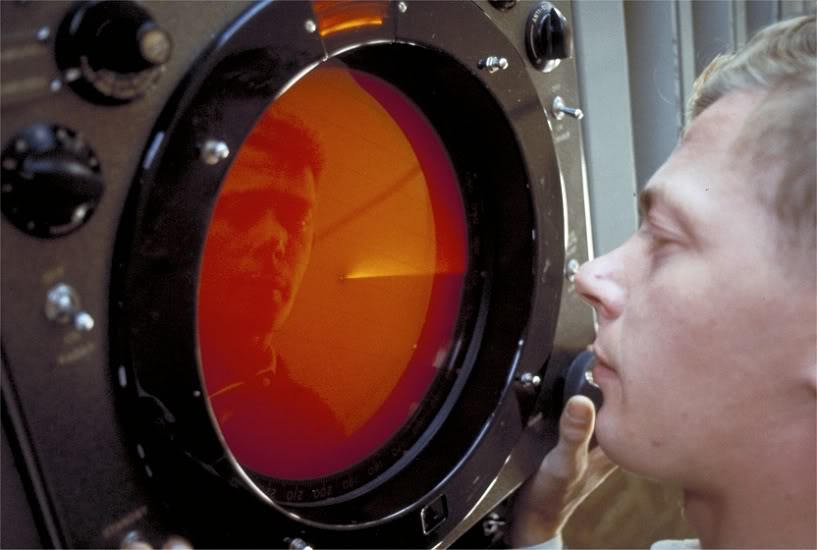
Photo : Burnett H. Moody/Saudi Aramco World/PADIA
It was at Cape Bon that Captain Jansen began to use his radar for more than brief explorations of conditions ahead. Normally-when traffic
and weather permit-he prefers that young officers stick as closely as is practicable to the visual sightings and manual plottings that have
guided mariners for centuries. This is no fetish. It is grounded in an eminently practical belief that although officers ought to cherish the
instrumentation available to them on all modern ships, they ought first to perfect the seamanship that no storm or power failure or
mechanical error can affect.
"The captain feels that instruments should help us with our jobs, not do them for us," one officer said.
"Of course," he added after a moment's reflection, "they are a considerable help."
He went on to say that because of improved instruments on the modern tanker, one officer alone can handle the ship and its operations in
situations that would send a Yankee shipmaster or a Captain Bligh galloping to his lifeboats. A good example, he said, was the console.
The console is a large gray steel cabinet slanted like a drafting board and looking rather like an 1BM computer, studded with switches,
dials and lights. With the console an officer on duty can, without budging, note the direction and force of the wind, scan the horizon with
the radar for a distance of 48 miles, sketch a charcoal profile of the bottom to a depth of 720 fathoms, instantly check shallow water down
to 30 feet, telephone to anyone on the ship, and—via VHF radio telephone—to ships up to 30 miles away. At the console he also can
switch on a 3,000-candlepower searchlight as big as a cannon, sound the steam and air whistles and the ship's alarm bells, operate the
loud hail and the public address systems, and-if he should have a moment or two to remember it-regulate the volume of the tape-recorded
music that plays steadily all day long throughout the ship.
And the console contains only part of the instrumented aids available. There is the automatic pilot that locks the ship on a prescribed
course. There is a 60-mile radar unit. There is the Decca Navigator, a special receiver that picks up a prearranged pattern of radio im-
pulses that are coordinated with markings on charts of certain waterways and enable navigators to check their position almost foot by
foot, second by second.
The operation of the more sophisticated instruments, especially at night, is at once eerie and comforting. It is eerie because the soft
flashes of the radar scanner circling the screen, the metronomic beat of the echo sounder drawing its jagged profile on the steadily un-
winding roll of recording paper, and the nervous flicker of the shallow-depth finder, bouncing on the panel like bright green quicksilver in
a tube, are like sights and sounds from science fiction. It is comforting because, paradoxically, its inhuman efficiency seems to pro-
mise an infallible security.
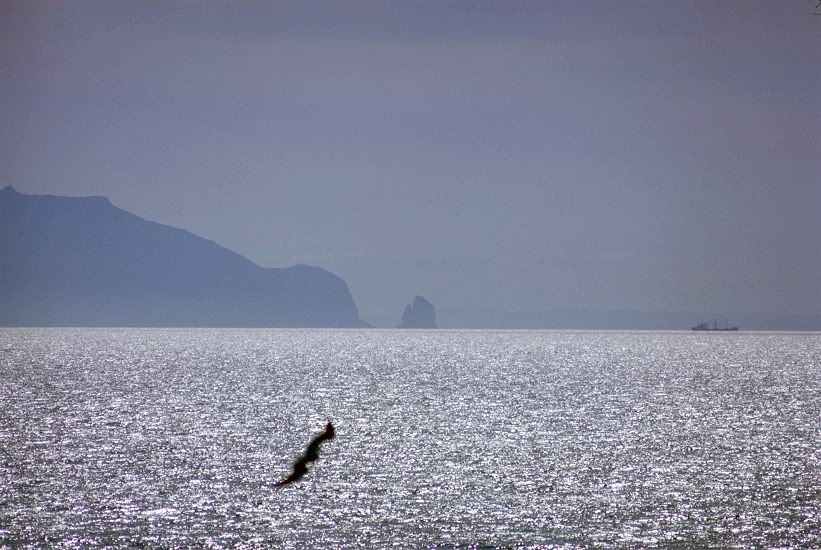
Photo : Burnett H. Moody/Saudi Aramco World/PADIA
It would be hard to think of a situation that such instruments could not either warn the officers about or help them face. Radar is a good
example. There are two radar sets on the Den Haag, one set flush in the face of the console like a great orange eye, the other mounted
in a curtained booth that looks like a take-it-yourself photo booth at an amusement park. The console radar is a "relative" radar-which
means that any object "seen" is seen only in relation to the ship's heading. In the exact center of the screen is a pinpoint of light with a
lighted line sweeping around and around like a ray of light from a lighthouse. The dot is the ship and the lighted line, the "sweep," is the
radar scanner that is spinning in unison with the signal line on the radar screen. When the scanner senses something-a ship, an island,
a bank of low clouds, or sometimes even a high wave-there is a flicker on the screen along the line at the point where the object is lo-
cated and the shape of it is momentarily outlined-rather like the dark areas on a photographic negative.
The radar in the booth is "true motion" radar and the difference is that this radar works like a television camera. It simply scans a given
area and projects a picture on the screen showing the Den Haag's actual position and movement in an area with a radius of 60 miles.
"It is really invaluable," said the officer, "but we prefer to use it only in fog or rain or when traffic is heavy, or when we're in a tight spot like
the Strait of Dover or the Strait of Gibraltar. Incidentally, we'll be stopping at Gibraltar tomorrow morning."
The Den Haag at that point had been at sea five days, steadily pushing west toward the Atlantic. The original course did not call for a
stop at Gibraltar but word came from the Netherlands that an engineer from England was flying out to meet the ship and conduct some
tests on the turbine during the rest of the trip. So, on the sixth day of the trip the Den Haag eased her long hull into Outer Harbor at the
foot of the great limestone cliff into which England, 262 years ago, carved the world's most famous fortifications.
It was a short halt—two hours at the most—and soon, the engine room telegraph clicking from slow astern to half speed ahead, the
tanker executed a smart pivot, steamed into the Atlantic and headed north along the coast of Portugal.
For the next few days the Den Haag seemed to speed through the sea with new vigor as if the fresh Atlantic winds had roused her from
a leisurely nap. Past flashed Cape St. Vincent, where Lord Nelson trapped the Spanish Fleet; the Cape of Trafalgar, where he issued
his famous "England expects that every man will do his duty," and then died; the Bay of Biscay, where Atlantic swells roll landward to
foam against the sea walls of San Sebastian and Biarritz; and finally past a line of white cliffs called Beachy Head and into the English
Channel.
On every voyage it seems, there is one place that ships approach warily. For some it may be the Cape of Good Hope or the Strait of
Magellan. For the Den Haag it was the English Channel and the Strait of Dover, that narrow gap of crowded water linking the Channel
to the North Sea and dividing France from England. All the way through the Mediterranean and up the coasts of Portugal and Spain
the officers of the Den Haag had spoken about the Strait of Dover. In the Strait, they said, the fog is as thick as plaster. In the Strait,
they said, the ships are as numerous as bees in a hive. There were reasons for those warnings—the knowledge of experience in an
area where the fog is dense, the evirrents are strong and the sea lanes are busy. And so, as darkness fell one night and the Den Haag
steamed into the notorious Strait, it was no surprise when Captain Jansen quietly took over the conn, when his officers began to drift
restlessly into the chartroom for a word with the officer on duty or a glance at the chart, or when two lookouts instead of one reported
to their stations. It was no surprise either that suddenly, for the first time, there was on the Den Haag a very real, very urgent sense of
concern.
To get through the Strait Captain Jansen had chosen to take the Den Haag between two shallow banks called the Varne and the Ridge
where, less than a mile from the ship's flanks, the depth of the water was less than nine feet. It was dark by the time the Den Haag
approached this channel and all around were the lights of other ships, freighters, liners, ferries and trawlers, all jockeying for position,
plotting courses, changing speeds and direction. Beyond, on the coast of England, headlights flashed on coastal roads. Across the
water there was France.
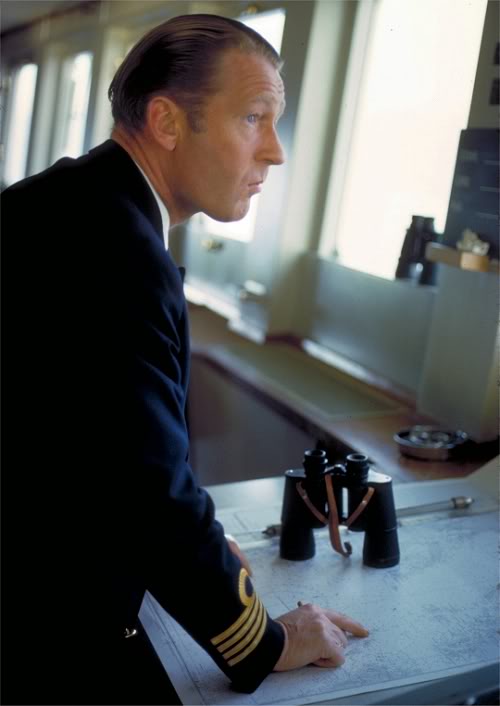
Photo : Burnett H. Moody/Saudi Aramco World/PADIA
The minutes ticked by. Standing by the chartroom table, his pipe forgotten, his face calm in the subdued cone of light beamed at the
chart, Captain Jansen measured an angle, walked his dividers along the penciled line that led alarmingly close to the shallows, and
x'd in a position. From time to time he walked over to glance at the Decca Navigator twitching and clicking in the light of a dim lamp,
or strode outside to sweep the coast with his rubber-cased binoculars, or stopped to have a word with the officer on duty. Occasionally
he would point to this beacon or that light and once he stopped to sip a cup of coffee and meditate on his latest entry, made in the
ship's log.
All at once he said, "We should be seeing that lightship about now; about two points off the port bow. Ah, there, you see? Now we're
through!"
And that was all. In minutes the tanker was gliding past Dover, past the Sandettie banks to starboard and South Falls to port, past the
dim beacon at Calais. Later there was the glitter of the Thames Estuary and the glow of London. Then, England was astern and the
Den Haag, with a regretful glance toward Rotterdam, her home port, plunged into the darkness of the North Sea.
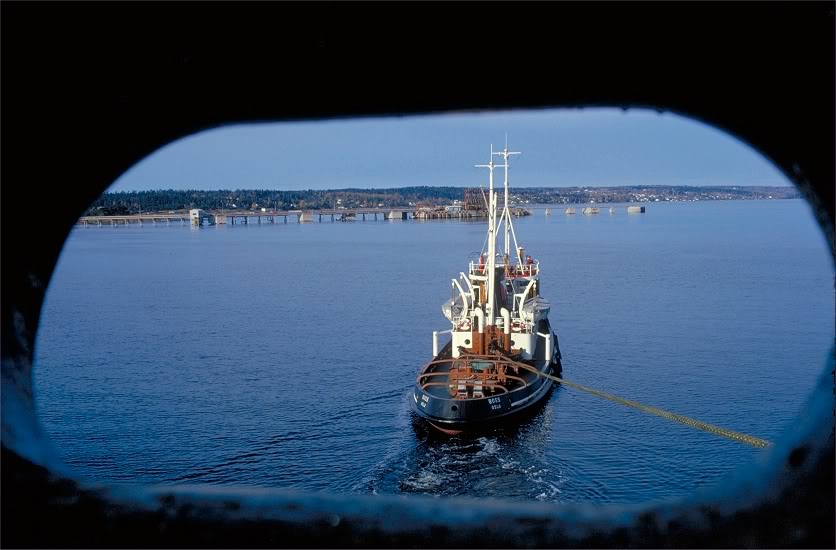
Photo : Burnett H. Moody/Saudi Aramco World/PADIA
After that the end of the voyage came rapidly. By dawn of the next day Norway was in sight, a jagged spire of rock poking from a cold
gray sea, an old stone lighthouse as red as a Vermont barn, and woods as crisp and colorful as New Hampshire in the fall. By mid-
morning the pilot was guiding the ship toward a finger of land in the fiord where green pipes stood tall on the shore and four tugboats
were casting off lines. Minutes later the tugs made for the Den Haag like hounds circling a bear, nipping at her quarters, nudging and
tugging at her bow and stern and hooking the ends of heavy hawsers out of the water and pulling the ship to shore. There, on a pier
angling out from a slope where storage tanks waited, the huge Chiksan loading arms were already dropping toward the manifold. On
the forecastle the steam from the winch hissed into the air, the hawsers tightened, sagged, and tightened for good. Then the ship
brushed the pier, seasoned workers coupled the arms to the manifold and the cargo pumps coughed and caught. Across the decks
came a cold breeze and into the now-deserted wheelhouse poured the pale sunlight of autumn. The voyage was over.
Source : Saudi Aramco World / PADIA